Called the Velocette model KTT, it had a series of "marks" to designate the major changes.
They ran from the Mk.1 to the Mk.8, although not all numbers were used.
There was not a Mk.2 for example, nor was there a Mk.6 for sale to the general public.
So we come to the model called the Mk.6 KTT, which I just said wasn't an actual model...??

At a glance you could think the title indicated a plural and readers of "Always in the Picture", the Velocette historical record written by Burgess and Clew; Dave Masters booklet on Velocette models; the "MotorCycle Sport" series "The Velocette Saga" and "Classic Motorcycles" to name a few could perhaps be heard to mutter that..." there was only one Mk.6 KTT, ridden by Austen Munks to a Junior Manx GP victory in 1936 and was never used in the IOM TT..."
Unfortunately all of the main characters involved with this project are now dead and so one can only surmise, but research on and off over the years has produced evidence that there was not one but three Mk.6 KTTs and that they were all ridden in the 1936 IOM Junior TT.
But let me re-phrase the "three Mk.6 KTTs" sentence...
There were in fact three prototype Mk.6 KTTs, for with the production of the Mk.5 KTT finishing in October 1935 with engine number KTT620 there was a gap of 17 months until the first of the Mk.7 KTTs, engine number KTT700 , was despatched to Australia.

It has been said by others before me what these Mk.6 KTTs looked like, with Harold Willis grafting the cylinder head from the newly released Mk.2 KSS roadster onto the crankcases of the Mk.5 KTT, with Willis reputed to having termed it "The little rough'un".
Another useful snippet of information comes to light in Les Higgins delightful book "Private Owner" which I have had on my bookshelves for years, which I reviewed in an earlier blog and which has just had it's umpteenth re-read.
Writing of the period of 1936, Higgins says on page 41...."another machine was difficult to come by, because Veloce Ltd. had temporarily ceased manufacture of the KTT model. The last machine made in any quantity were the Mk.5 models. A few Mk.6 machines went out to approved customers and the concern was now busy evolving something new to provide an answer to the International Norton".
I've include various photos of these three Mk.6 KTTs, ridden by Newman, Tiffin and the Frenchman Roger Loyer and then a 1937 photo with Ernie Thomas, another unlabelled and one featuring the Archer's, father and son on 10 June 1937 and because of the date likely to be in the IOM at the TT races.
An extract from the Velocette factory KTT records shows....
June 1936 Veloce for H.E. Newman for TT KTT621......frame 6TT3
June 1936 Veloce for W.T.Tiffing Jnr for TT...KTT622.. .frame 6TT4
June 1936 Veloce for Loyer for TT....................KTT623 frame 6TT5

The reference "Veloce for" or "Veloce Ltd for TT" is always used throughout the factory KTT records to indicate a factory prepared racer. Similarly the frame designation 6TT was used on the factories rigid framed TT racers.
From the weekly motorcycle paper "MotorCycling" of June 17 1936 in the "Straight from the Island" article is another interesting snippet, obviously overlooked by historians.
"One or two of the lads who are riding Velocettes, notebly H.E Newman, will be mountedon advance KTT jobs for 1937. These are standard products, but they can motor very rapidly".
After all that, how did they fare in the TT?
Billy Tiffin retired at the end of lap three with a broken front fork spring and Roger Loyer ( the Frenchman, usually entered by Boudene the Velo agent from Paris) stopped soon after his 5th lap pit stop and retired with "lubrication trouble of an irremediabule kind"
That left Newman and he came in 10th, the third Velocette to finish. Those in front of him being Ted Mellors in 3rd place and Ernie Thomas in fourth place, both mounted on 'works' DOHC 350 Velos, again a feature for a later blog on DOHC Velocettes, both prewar and postwar, for there were three entered in the 1936 TT races and not one as is normally surmised.
Newmans lap times are not spectacular, but are consistent around the 30 minute mark with a fastest lap of 28 min.58 secs and he was marginally slower than the 'works' DOHC Velos and faster than the other Mk.5 KTTS ridden by Noel Pope, Gledhill and NZer, Chas.Goldberg.

Development seemed to continue, for the photo of Ernie Thomas mounted on a Mk.6 KTT in the 1937 Junior IOM TT seems to be the one that Newman used in 1936 except for the seat.
As mentioned, Archers', well known Velocette agents, had a Mk.6 KTT for the 1937 TT.

Above is a photo of Noel Pope in 1937, mounted on what appears to be a Mk.6 KTT.

Ernie Thomas's 1937 Mk.6 KTT, drive side view.
Some interesting items that can be seen in the photos are the seats - the "dual" seat arrangement was introduced on factory racers in 1934; the large petrol tank that was to be introduced on the KTT production racers with the Mk.7 in late March 1938, but featured on factory bikes for the first time in the TT in 1936.
The rear wheel of Archer's Mk.6 KTT has a conical hub fitted and of course this can only have come from a factory racer, as it wasn't introduced on a production KTT until the Mk.8 KTT appeared in April 1939.
So why didn't the Mk.6 continue into full production?
Perhaps with the introduction of the massive square finned SOHC engine ( 10" x 10") to the factory bikes and the subsequent bettering of existing lap times, Willis chose this line of development.
Stanley Woods was lapping over 1min.17secs. a lap faster than Ernie Thomas in the 1937 Junior TT, despite the obvious time that must have been spent on the Mk.6 in the intervening year.
Thomas's best time was only marginally better than that of Newman's of the year before.
In the Manx GP of 1936, the Mk.6's only known victory, Austen Munk's best lap was slower than the best Junior time in the 1935 and his race average was 0.1mph faster than Newman's in the previous June TT.
I further reviewed literature I hold, including some factory blueprint drawings.
Drawing KO2716 of part no. K27/16, a piston and described on the drawing as being for KTT Mk.6 and drawing KO2805, part no. K28/5 a connecting rod, also described as for KTT Mk.6 proved to be the answer.
Inspection of a K27/16 piston from my Mk.8 KTT revealed it to be, as was to be expected, identical with the drawing and of course the instruction sheet put out by Veloce Ltd. for the Mk.7 and Mk.8 KTTs list the K27/16 piston as the Mk.7 alcohol piston and the Mk.8 KTT petrol-benzol piston.
A close look at the photographs showed the cylinder of the Mk.6 to be the same as the Mk.7 and Mk.8.
So I feel the Mk.6 was in fact a Mk.7 engine type but with a KSS Mk.2 cylinder head fitted.
After testing, in the TT and MGP of 1936 and 1937, together with some Continental GPs ( according to the late Bruce McNair's conversations with Roger Loyer) the Mk.2 KSS head must have been found to be unsatisfactory and replaced by the present Mk.7/8 type, very close to the "works" 1937 cylinder heads ( although only 9" x 9" square ) and the machine was offered for sale to the public as the Mk.7 in 1938.
Other detail changes from what appear to have been Mk.6 "specification" appear to be the fitment of the Elektron front brake plate with air scoop, the adoption of the larger "works" oil tank and the selection of the unstrutted, double damped TT Webb forks as fittted to "works" machines from 1936 and to Newman's 1936 and Thomas's 1937 Mk.6s in preference to the strutted KTT type together with the dropping of the "Loch Ness Monster" seat in favour of a conventional seat with rear mudguard air pad and the addition of a tachometer completed the change.
But why was the Mk.2 KSS cylinder head dropped?
For the combustion chamber of the KSS head was virtually identical with that of the larger Mk.7 head. Even valve sizes were the same.
Perhaps there was trouble with the coil valve springs in the Mk.2 head at the sustained higher rpm inevitable in racing and the re-adoption of hairpin valve springs to overcome this would have meant re-designing the head or the fitment of the previous KTTs head.
Similarly the relatively scanty finning on the Mk.2 head under the higher power developed by these late 1930s engines on petrol benzol, which has a tendency to run hot, may have caused problems and so the reversion to the previous years "works" head was an easy solution.
My "arm chair" treatise, above, may well be the solution for the Mk.6 KTT conundrum.
Left click on images to enlarge...



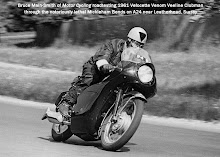

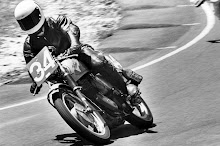

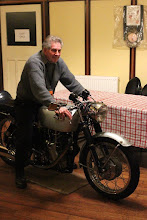
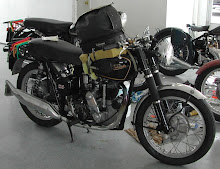
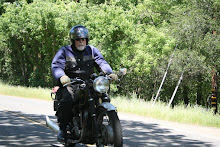


2 comments:
Hi Dennis,
As usual I enjoyed this latest post, your blog is excellent for me as a Velo fellow!
You do know that Gerd B. from Germany has a restored Mk 6?
I have lot's of photo's if you are intrested.
Regards
John from Holland
Dennis those photographs are beautiful, especially the last two. I take it you sorted out your 'issues' with Blogger? The post looks good!
Post a Comment